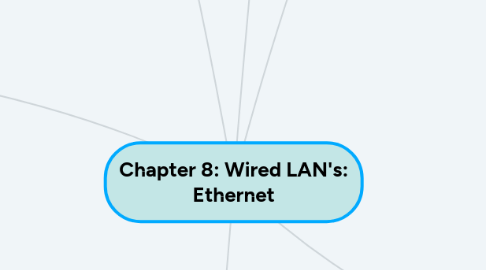
1. FAST ETHERNET
1.1. MAC Sublayer
1.1.1. access method the same (CSMA/CD); except full duplex
1.1.2. frame format = Traditional Ethernet
1.1.3. autonegotiation; allows 2 devices to negotiate the mode/data rate of operation
1.2. Physical Layer
1.2.1. Reconciliation Sublayer (RS)
1.2.1.1. replaces PLS in 10-Mbps Ethernet
1.2.1.2. responsible that left over
1.2.1.3. passing of data in 4-bit format to the MII
1.2.1.4. encoding and decoding; PLS moved to PHY sublayer
1.2.1.5. encoding is medium-dependent
1.2.2. Medium-Independent Interface (MII)
1.2.2.1. replaces AUI in 10-Mbps
1.2.2.2. improved interface; 10-Mbps & 100-Mbps
1.2.3. PHY Sublayer
1.2.3.1. transceiver; responsible for encoding & decoding
1.2.4. Medium-Dependent Interface (MDI)
1.2.4.1. piece of hardware; connecting transceiver to the medium
1.3. Physical Layer Implementation
1.3.1. 100Base-TX
1.3.1.1. 2 pairs of twisted cable in physical star topology
1.3.1.2. allows either external transceiver with MII cable OR internal transceiver
1.3.1.3. transceiver; transmitting, receiving, detecting & encoding/decoding data
1.3.2. 100Base-FX
1.3.2.1. 2 pairs of fiber optic cable in physical star topology
1.3.3. 100Base-4T
1.3.3.1. 4 pairs of UTP for transmit 100 Mbps
2. GIGABIT ETHERNET
2.1. MAC Sublayer
2.1.1. 2 distinctive approaches medium access: half duplex using CSMA/CD or full-duplex without CSMA/CD
2.1.2. no collision; max length determined by signal attenuation
2.2. Physical Layer
2.2.1. RS
2.2.1.1. sends 8-bit parallel data to the PHY sublayer via a GMII interface
2.2.2. Gigabit Medium-Independent Interface (GMII)
2.2.2.1. specification that defines how RS is to be connected to the PHY sublayer
2.2.2.2. counterpart of MII in Fast Ethernet
2.2.2.3. primarily a logical rather than a physical interface
2.2.3. PHY Sublayer
2.2.3.1. transceiver that medium-dependent
2.2.3.2. encodes & decodes; internal only
2.2.4. MDI
2.2.4.1. connect transceiver to the medium
2.2.4.2. RJ-45 & fiber optic connectors are defined
2.3. Physical Layer Implementation
2.3.1. 1000Base-SX
2.3.1.1. 2 -wire short-wave fiber
2.3.1.2. designed with internal transceiver
2.3.2. 1000Base-LX
2.3.2.1. 2-wire long-wave fiber
2.3.3. 1000Base-CX
2.3.3.1. 2-wire copper (STP)
2.3.4. 1000Base-T
2.3.4.1. 4-wire UTP
3. TEN-GIGABIT ETHERNET
3.1. GOALS
3.1.1. upgrade the data rate to 10Gbps
3.1.2. make it compatible with Standard, Fast and Gigabit Ethernet
3.1.3. make Ethernet compatible with technologies such as Frame Relay and ATM
3.1.4. use the same 48-bit address
3.1.5. allow interconnection of existing LANs into a MAN or a WAN
3.1.6. use the same frame format
3.1.7. same min & max frame length
3.2. not uses CSMA/CD
4. IEEE STANDARDS
4.1. Data Link Layer
4.1.1. logical link control (LLC) sublayer
4.1.2. medium access control (MAC) sublayer
4.2. Physical Layer
4.2.1. physical layer signaling (PLS) sublayer
4.2.2. attachment unit interface (AUI)
4.2.3. medium attachment unit (MAU)
4.2.4. medium dependent interface (MDI)
5. ETHERNET EVOLUTION
5.1. Standard Ethernet (10 Mbps)
5.2. Fast Ethernet (100 Mbps)
5.3. Gigabit Ethernet (1000 Mbps)
5.4. Ten-Gigabit Ethernet (10 Gbps)
6. STANDARD ETHERNET
6.1. MAC Sublayer
6.1.1. governs the operation of the access method
6.1.2. frames data received from the upper layer & passes them to the PLS sublayer for encoding
6.1.3. Frame Format
6.1.3.1. preamble
6.1.3.2. start frame delimiter (SFD)
6.1.3.3. destination address (DA)
6.1.3.4. source address (SA)
6.1.3.5. length of protocol data unit (PDU)
6.1.3.6. data
6.1.3.7. CRC
6.1.4. Frame Length
6.1.4.1. Ethernet imposed restrictions on both min & max length of frame
6.1.4.2. min frame = 64 bytes
6.1.4.3. max frame = 1518 bytes
6.1.5. Addressing
6.1.5.1. unicast destination = one-to-one
6.1.5.2. multicast destination = one-to-many
6.1.5.3. broadcast destination = all the stations on the network
6.2. Physical Layer
6.2.1. PLS
6.2.1.1. encodes & decodes data
6.2.1.2. Manchester encoding with data rate of 10 Mbps
6.2.2. AUI
6.2.2.1. interfaces between the PLS & MAU
6.2.3. MAU
6.2.3.1. transceiver
6.2.3.1.1. transmitter
6.2.3.1.2. receiver
6.2.3.2. transmit signals over the medium, receives signals over the medium
6.2.3.3. detect collisions
6.2.4. MDI
6.2.4.1. piece of hardware for connecting a transceiver to the medium
6.2.4.2. tap external transceiver or jack internal transceiver
6.3. Physical Layer Implementation
6.3.1. 10Base5: Thick Ethernet
6.3.1.1. bus topology with external transceiver
6.3.1.2. connected via tap to a thick coaxial cable
6.3.2. 10Base2: Thin Ethernet
6.3.2.1. Cheapernet
6.3.2.2. bus topology with internal transceiver
6.3.2.3. point-to-point connection via external transceiver
6.3.3. 10Base-T: Twisted-Pair Ethernet
6.3.3.1. physical star topology with internal/external transceiver connected to hub
6.3.4. 10Base-F: Fiber Link Ethernet
6.3.4.1. star topology to connect stations to hub
6.4. Evolution
6.4.1. Bridge Ethernet
6.4.1.1. unbridged ; total capacity is shared between all networks
6.4.1.2. divides 2 or > networls, BW each network is independent
6.4.1.3. Advantages
6.4.1.3.1. capacity shared between smaller stations
6.4.1.3.2. collision domain becomes smaller
6.4.2. Switched Ethernet
6.4.2.1. BW only shared between the station & the switch
6.4.2.2. collision domain is divided into N domains
6.4.2.3. additional sophistication; allows faster handling of the packets
6.4.3. Full-Duplex Ethernet
6.4.3.1. send/receive data at the same time simultaneously
6.4.3.2. increases the capacity of each domain from 10 to 20 Mbps

